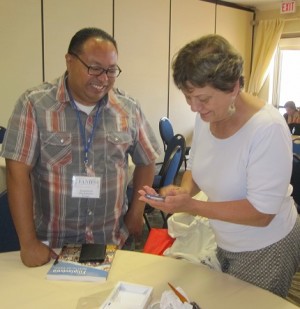Fil-Am descendants proud of their ‘manong’ fathers
(Part 2)
[“Because countless Filipinos worked in, passed through, and settled here (Stockton), it became the crossroads of Filipino America. Yet immigrants were greeted with signs that read ‘Positively No Filipinos Allowed’ and were segregated to a four-block area centered on Lafayette and El Dorado Streets, which they called ‘Little Manila.’ In the 1970s, redevelopment and the Crosstown Freeway decimated the Little Manila neighborhood. Despite these barriers, Filipino Americans have created a vibrant ethnic community and a rich cultural legacy. Filipino immigrants and their descendants have shaped the history, culture, and economy of the San Joaquin Delta area” –Dawn Bohulano Mabalon, “Little Manila is in the Heart.”]
SAN DIEGO, California — Dillon Delvo, son of farm laborer Cipriano “Rudy” Delvo, like his counterpart Ron Perez, son of writer Frank Perez, is young to be the son of a manong. I met both of them at the Filipino American National Historical Society (FANHS) conference weekend of July 31. Their fathers came as teenagers to America in the late 1920s/early 1930s.
One of the reasons Dillon’s father hadn’t married earlier was because of the anti-miscegenation laws that were in effect until the late 1940s. Dillon was so much younger than his father that his playmates at school thought Rudy Dillon was his grandfather, and he was sometimes so ashamed that he would say, “Yes, that’s my grandfather.”
It wasn’t until Dillon started taking Asian American Studies at San Francisco State University that he learned his father’s history. It was then that he realized how much his father had sacrificed and why he had to wait so long to get married. “Now I can say, ‘I am the son of a manong, and I am very proud of my father.” Dillon has continued the advocacy of his father and co-founded the Little Manila Foundation in Stockton.
“Rudy” Delvo was the other man who came back to life at the conference. His son, Dillon, was on the same panel that Dawn Mabalon had participated in the day before. Dillon and Dawn had been in third grade together, and they both said that they had to leave Stockton to learn how important it was to Filipino American history and to them personally.
Article continues after this advertisementDillon told TheFilamLA that Filipinos had gone on strike in a large and organized way as early as the 1920s and that his father was one of the leaders of these early strikes. I was surprised by this, and later I read in Mabalon’s book that in 1948, members of Local 7 of the United Cannery, Agricultural, Packing and Allied Workers of America who also included veterans of the 1930s organizing campaigns (Delvo and Itliong, among them), carried out the largest strike since 1939. As a result of his participation in the 1948 strike, Rudy Delvo, who was among the hundreds of striking workers evicted on the second day, “lost all of his belongings: his trailer, clothing, cooking utensils, bedding, radio and groceries.
Article continues after this advertisementThe younger Dillon stated that altogether, more than 4,000 workers went on strike, and Philip Vera Cruz from Delano, who became a renowned farm labor organizer, went on strike for the first time in his life.
Dillon further said that his father had brought Larry Itliong, who was in Seattle, into the Stockton asparagus union organizing and that they continued working together, forming the Agricultural Workers organizing Committee (AWOC). Later, they planned and executed the famous September 8, 1965 strike against the grape growers in Delano and carried out what is now historically known as the Great Grape Delano Strike, which improved the working conditions of the farmers.
Urban planner Gerald Gubatan, co-chair of FANHS Biennial Conference held in Los Angeles in 2002 cites the important endurance of oldtimers such as Frank Perez and Rudy Delvo in documenting the Filipinos’ impact in various American communities. Gerald writes: “Perez served as editor of the Los Angeles-based Philippine Star News from roughly the 1930s through the 1950s, I think — before he relocated to Stockton.”
Gubatan remembers reading an amazing quote by Frank Perez about Los Angeles and the manongs’ dreams of building the community.
These are brief stories of only two men out of 20,000 Filipino American men, women and children who lived in Stockton once upon a time. Many of their stories have been told. How many thousands more are waiting to be told and in how many cities and towns across America? The Filipino American National Historical Society is looking for your story.
(Author Carlene Sobrino Bonnivier is the newest addition to TheFilAmLA’s group of contributing writers dedicated to documenting the significant presence of Filipino Americans in the U.S. She has just recently co-published with Gerald Gubatan, urban planner and Gregory Villanueva, F.A.I.A. architect the anthology Filipinotown: Voices from Los Angeles, now on its second edition [with a teacher’s guide].)
RELATED STORIES
Fil-Am history confab finds living link to a manong’s disrupted life
Two important Fil-Am confabs get major sponsor
Historical society pans ‘Cesar Chavez’ film for inaccuracies
